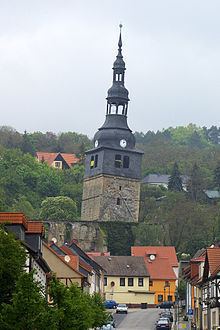Postal codes 06567 Population 9,097 (31 Dec 2008) | Time zone CET/CEST (UTC+1/+2) Dialling codes 034671 Local time Tuesday 12:18 AM | |
 | ||
Weather 11°C, Wind SW at 29 km/h, 69% Humidity Points of interest Panorama Museum, Der Schiefe Turm, Regionalmuseum, Hausmannsturm | ||
Bad frankenhausen panorama kurzer rundflug
Bad Frankenhausen (officially: Bad Frankenhausen/Kyffhäuser) is a spa town in the German state of Thuringia. It is located at the southern slope of the Kyffhäuser mountain range, on an artificial arm of the Wipper river, a tributary of the Unstrut. Because of the nearby Kyffhäuser monument dedicated to Emperor Frederick Barbarossa, it is nicknamed Barbarossastadt. The municipality includes the villages of Seehausen, Udersleben and (since 2007) Esperstedt.
Contents
- Bad frankenhausen panorama kurzer rundflug
- Map of 06567 Bad Frankenhausen Germany
- History
- Peasants War Panorama
- Sights
- Notable people
- Twin town
- Literature
- References
Map of 06567 Bad Frankenhausen, Germany
History
Frankenhausen was first attested as a Frankish settlement in the 9th century in deeds of the Abbey of Fulda. It received town privileges in 1282 and from 1340 on was part of the County of Schwarzburg.
On May 15, 1525 it was the location of the Battle of Frankenhausen, one of the last great battles of the German Peasants' War, when the insurgent peasants under Thomas Müntzer were defeated by troops of the allied Duke George of Saxony, Landgrave Philip I of Hesse and Duke Henry V of Brunswick-Lüneburg. Müntzer was captured, tortured and finally beheaded at Mühlhausen on May 27.
With the partition of Schwarzburg County in 1599, Frankenhausen became the capital of the Unterherrschaft subdivision of the County of Schwarzburg-Rudolstadt, which in 1710 was raised to a principality. Prince Günther Victor was the last German monarch to abdicate, on November 23 (as Prince of Schwarzburg-Rudolstadt) and November 25, 1918 (as Prince of Schwarzburg-Sondershausen). The succeeding short-lived Free State of Schwarzburg-Rudolstadt merged into the newly created Thuringia in 1920.
Since 1818 a saline water well that had been used for centuries to extract salt has been used for saline baths and medical purposes. Therefore in 1927 Frankenhausen received the official title of a spa town (Bad). In the 19th century the town was also famous for the manufacture of pearl buttons. Today it mainly depends on tourism and spa vacation.
Since 1972 Frankenhausen has been a garrison town, formerly of a motorised infantry regiment of the National People's Army, from 1990 on of the 13th Mechanized Infantry Division of the German Army.
Peasants' War Panorama
Based on Friedrich Engels' 1850 book The Peasant War in Germany, Thomas Müntzer as an early revolutionary became an icon of historical materialism in East Germany. At the 450-years jubilee of the battle, the Socialist Unity Party of Germany (SED) charged the rector of the Leipzig Academy of Visual Arts, Professor Werner Tübke, with the creation of a monumental panorama painting. The work in a specially erected rotunda was finished in 1987. It is 123 m/404 ft in length and 14 m/46 ft in height and depicts more than 3000 individuals.
Despite the Politburo's plans modelled on the Battle of Borodino panorama at Poklonnaya Hill in Moscow, Tübke realised a rather pessimistic vision of a resigned Müntzer standing alone among battling troops, a Bundschuh flag on the ground at his side. The Panorama was inaugurated by Kurt Hager and Margot Honecker as deputy for her husband on September 14, 1989, thus eight weeks before the fall of the Berlin Wall. Today the Panorama Museum displays art shows and a collection of works of contemporary international artist.
